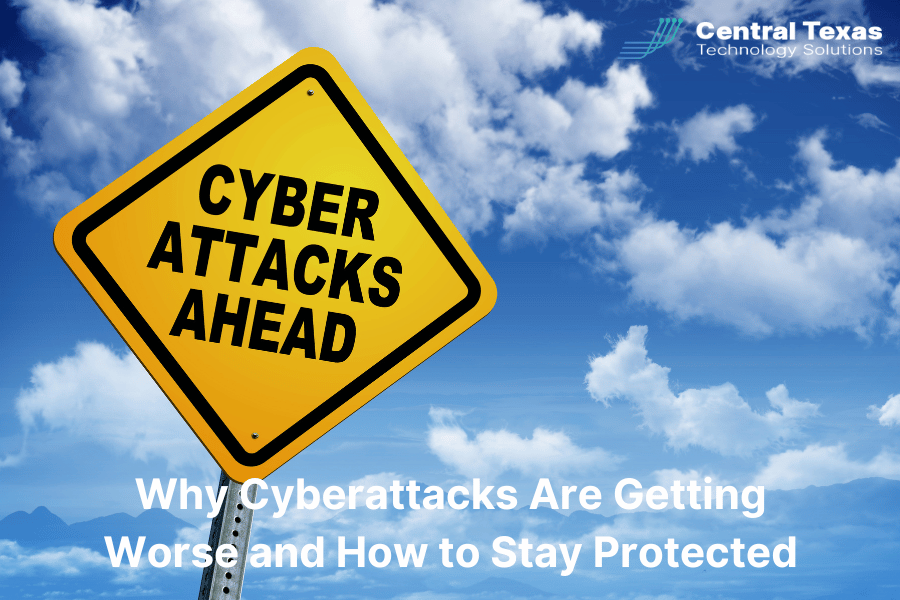
Cyberattacks are no longer a distant possibility - they're a daily reality for businesses of all sizes. Whether you’re a small company or a large enterprise, the risks are growing, and the stakes have never been higher.
Fortunately, you don’t have to be a sitting duck. By understanding the risks and implementing proactive strategies, your business can stay protected and ready to respond.
The Rise of Cyberattacks in the Modern Business World
Cybercrime has moved beyond movie plots and big-name breaches. It’s a real-world threat affecting companies across industries. The very technology that helps us operate faster and smarter also creates new doors for hackers to walk through.
From email scams to AI-powered attacks, criminals are constantly evolving their methods, and no one is off-limits. Even global companies like Microsoft have fallen victim to these increasingly complex tactics.
Why Are Cyberattacks Getting Worse?
Technology is advancing rapidly, and unfortunately, so are the tools cybercriminals use. These factors are driving the increase in cybercrime:
-
The rise of remote work and cloud-based systems creates more access points.
-
AI and automation are making it easier to launch widespread attacks.
-
Cybercriminals are becoming better funded and more organized.
-
Businesses often underestimate their vulnerability until it’s too late.
Common Types of Cyberattacks Targeting Businesses
Cyberattacks come in many forms, each with its own level of damage and complexity. Here are some of the most common threats businesses face today:
-
Ransomware: Hackers lock your systems and demand a ransom to restore access. Even if you pay, there’s no guarantee your data will be safe.
-
Denial-of-Service (DoS) Attacks: These attacks flood your server with traffic, making your systems crash and interrupting service.
-
Phishing: Cybercriminals send deceptive emails to trick employees into giving away passwords or clicking on malicious links.
-
Supply Chain Attacks: Hackers target your vendors or partners to gain access to your systems indirectly.
-
Zero-Day Exploits: Criminals exploit unknown vulnerabilities in software before the developer can release a fix.
-
AI-Driven Threats: Attackers now use AI to craft more convincing phishing messages and detect weak spots faster than ever.
How to Stay Ahead of Cyberattacks
The best way to fight back is to get proactive. Prevention and early detection can reduce the impact of a cyberattack—or stop one before it starts.
Here’s how your business can prepare:
1. Train Your Team
Employees are often the first line of defense. Teach them how to spot suspicious emails, use strong passwords, and report unusual activity.
2. Run Background Checks
While most mistakes are unintentional, insider threats can come from malicious employees. Vet new hires carefully, especially those with access to sensitive information.
3. Strengthen Login Security
-
Use strong, unique passwords for all systems
-
Enable multi-factor authentication (MFA)
-
Regularly review and update access privileges
4. Back Up Critical Data
Make regular backups of:
-
Financial documents
-
Client and employee records
-
Project files and databases
Automate this process and store backups in a secure offsite location or cloud platform.
5. Keep Software Up to Date
Install updates and patches as soon as they become available. Unpatched software is one of the easiest ways for hackers to get in.
6. Use Layers of Protection
Don’t rely on a single security tool. Combine:
-
Firewalls
-
Antivirus software
-
Intrusion detection systems
The more layers you have, the harder your network is to breach.
7. Consider Cybersecurity Insurance
Even with the best protection, things can go wrong. Cyber liability insurance can help cover financial losses from attacks or data breaches.
Don’t Wait for a Wake-Up Call
Every day that passes without a cybersecurity strategy is a risk. The cost of doing nothing is often higher than the investment it takes to prepare. Start with training, tighten your defenses, and talk to a trusted IT partner about how to protect your business.
If you're unsure where to begin, CTTS is here to help. We specialize in helping Central Texas businesses build smart, secure IT environments that grow with them.
Frequently Asked Questions About Cyberattacks
1. Are small businesses really at risk of cyberattacks?
Yes. In fact, small businesses are often seen as easy targets because they typically have fewer cybersecurity resources in place.
2. What’s the first step I should take to protect my business?
Start by educating your team. Human error is one of the top causes of cyber incidents, and training your staff is a cost-effective first defense.
3. How often should I update my cybersecurity plan?
You should review your cybersecurity policies at least once a year—or whenever you add new technology, software, or team members.
Contact CTTS today for IT support and managed services in Austin, TX. Let us handle your IT so you can focus on growing your business. Visit CTTSonline.com or call us at (512) 388-5559 to get started!
